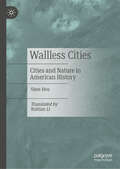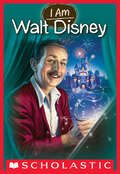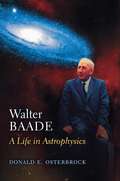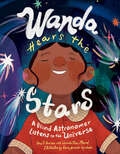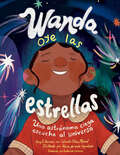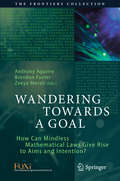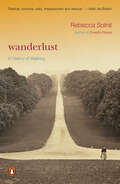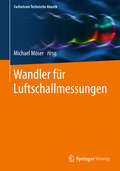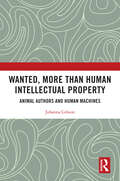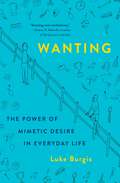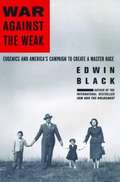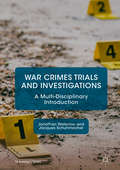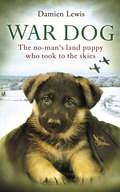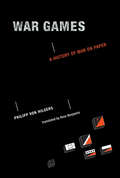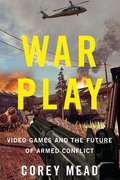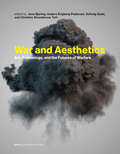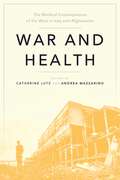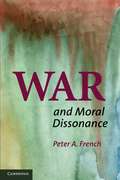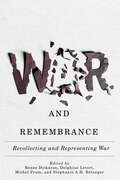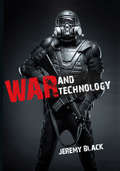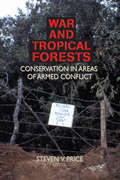- Table View
- List View
Wallless Cities: Cities and Nature in American History
by Shen HouThis book aims to outline the detailed process of integrating nature and cities in a historical context through the lens of urban environmental history, capturing how the most ordinary yet enduring natural forces have shaped the form of cities and the thoughts of individuals. It provides a detailed examination of the development trends, achievements, and existing issues in this field, and a profound understanding of the urgency and necessity of nurturing new ideas to guide cities out of their "ecological paradox". It also summarizes the formation and development, challenges, and missions of American cities centered around the core image of the "City Without Walls".
Walt Disney (I Am #11)
by Ms. Grace NorwichI am the creator of Mickey Mouse. I am Walt Disney.As a child, I had a wild imagination and a great curiosity. As I grew up, I used those qualities to become a cartoonist. Eventually, I turned these drawings into films and began my own animation business. One of my characters, Mickey Mouse, became so popular that movie theaters sold out and I won an Academy Award. After pursuing a career as a film producer, director, screenwriter, voice actor, entrepreneur and entertainer, I added developer to my resume when I created Disneyland amusement park. I became tremendously successful and beloved by children of all ages because of my belief that even the impossible is possible. I am Walt Disney.To this day, Walt Disney's characters remain some of the most recognizable images in the world. With books, TV shows, films, and amusement parks devoted to his creations, the Walt Disney name lives on. Learn all about this remarkable man's fascinating life in Scholastic's biography series, I AM.
Walter Baade: A Life in Astrophysics
by Donald E. OsterbrockAlthough less well known outside the field than Edwin Hubble, Walter Baade was arguably the most influential observational astronomer of the twentieth century. Written by a fellow astronomer deeply familiar with Baade and his work, this is the first biography of this major figure in American astronomy. In it, Donald Osterbrock suggests that Baade's greatest contribution to astrophysics was not, as is often contended, his revision of Hubble's distance and age scales for the universe. Rather, it was his discovery of two distinct stellar populations: old and young stars. This discovery opened wide the previously marginal fields of stellar and galactic evolution--research areas that would be among the most fertile and exciting in all of astrophysics for decades to come. Baade was born, educated, and gained his early research experience in Germany. He came to the United States in 1931 as a staff member of Mount Wilson Observatory, which housed the world's largest telescope. There, he pioneered research on supernovae. With the 100-inch telescope, he studied globular clusters and the structure of the Milky Way, every step leading him closer to the population concept he discovered during the wartime years, when the skies of southern California were briefly darkened. Most Mount Wilson astronomers were working on weapons-development crash programs devoted to bringing Baade's native country to its knees, while he, formally an enemy alien in their midst, was confined to Los Angeles County but had almost unlimited use of the most powerful telescope in the world. After his great discovery, Baade continued his research with the new 200-inch telescope at Palomar. Always respected and well liked, he became even more famous among astronomers as they shifted their research to the fields he had opened. Publicity-shy and seemingly unconcerned with publication, however, Baade's celebrity remained largely within the field. This accomplished biography at last introduces Baade--and his important work--to a wider public, including the newest generation of skywatchers.
Wanda Hears the Stars: A Blind Astronomer Listens to the Universe
by Amy S. Hansen WANDA DÍAZ MERCEDA nonfiction picture book biography of astrophysicist Wanda Díaz Merced and how losing her sight didn't stop her from studying the stars.An inspiring true story of a woman scientist of color that's a riveting intersectional read for STEM fans ages 6-9.Growing up in Puerto Rico, Wanda Díaz Merced wanted to learn everything she could about the stars. But in college she started losing her sight. How could she study what she couldn't see?Wanda found a way. She learned to hear the stars using sonification, which converts data into sounds. Listening to those chimes and drumbeats, she made new discoveries about the universe.Today Wanda is a leading advocate for inclusive science. She and her friend Amy S. Hansen collaborated on this book to inspire children to follow their curiosity no matter the challenges. As Wanda urges, "Never give up!" Wanda Hears the Stars is the perfect picture book biography to inspire any STEM-minded future scientist!
Wanda oye las estrellas (Spanish Edition): Una astrónoma ciega escucha al universo
by Amy S. Hansen WANDA DÍAZ MERCED¡Edición en español! Un libro ilustrado de no ficción que narra la biografía de la astrofísica Wanda Díaz Merced y cómo perder la vista no la detuvo de estudiar las estrellas.Una historia inspiradora y real de una mujer científica de color y que es una lectura interseccional fascinante para los fanáticos de STEM de 6 a 9 años.Spanish language edition! A nonfiction picture book biography of astrophysicist Wanda Díaz Merced and how losing her sight didn't stop her from studying the stars.An inspiring true story of a woman scientist of color that's a riveting intersectional read for STEM fans ages 6-9.Mientras crecía en Puerto Rico, Wanda Díaz Merced quería aprender todo lo que pudiera sobre las estrellas. Pero en la universidad comenzó a perder la vista. ¿Cómo podría estudiar lo que no podía ver?Wanda encontró una manera. Aprendió a escuchar las estrellas usando la sonificación, estudio que convierte los datos en sonidos. Al escuchar esas campanadas y ritmos de tambor, hizo nuevos descubrimientos sobre el universo.Hoy día, Wanda es una destacada defensora de la ciencia inclusiva. Ella y su amiga Amy S. Hansen colaboraron en este libro para inspirar a los niños a seguir su curiosidad sin importar los desafíos. Como insta Wanda, "¡Nunca te rindas!"¡Wanda oye las estrellas es la biografía ilustrada perfecta para inspirar a cualquier futuro científico con mentalidad STEM!Growing up in Puerto Rico, Wanda Díaz Merced wanted to learn everything she could about the stars. But in college she started losing her sight. How could she study what she couldn't see?Wanda found a way. She learned to hear the stars using sonification, which converts data into sounds. Listening to those chimes and drumbeats, she made new discoveries about the universe.Today Wanda is a leading advocate for inclusive science. She and her friend Amy S. Hansen collaborated on this book to inspire children to follow their curiosity no matter the challenges. As Wanda urges, "Never give up!"Wanda escucha las estrellas is the perfect picture book biography to inspire any STEM-minded future scientist!
Wandering Towards a Goal: How Can Mindless Mathematical Laws Give Rise To Aims And Intention? (The Frontiers Collection)
by Anthony Aguirre Brendan Foster Zeeya MeraliThis collection of prize-winning essays addresses the controversial question of how meaning and goals can emerge in a physical world governed by mathematical laws. What are the prerequisites for a system to have goals? What makes a physical process into a signal? Does eliminating the homunculus solve the problem? The three first-prize winners, Larissa Albantakis, Carlo Rovelli and Jochen Szangolies tackle exactly these challenges, while many other aspects (agency, the role of the observer, causality versus teleology, ghosts in the machine etc.) feature in the other award winning contributions. All contributions are accessible to non-specialists.These seventeen stimulating and often entertaining essays are enhanced versions of the prize-winning entries to the FQXi essay competition in 2017.The Foundational Questions Institute, FQXi, catalyzes, supports, and disseminates research on questions at the foundations of physics and cosmology, particularly new frontiers and innovative ideas integral to a deep understanding of reality, but unlikely to be supported by conventional funding sources.
Wanderlust: A History of Walking
by Rebecca SolnitDrawing together many histories-of anatomical evolution and city design, of treadmills and labyrinths, of walking clubs and sexual mores-Rebecca Solnit creates a fascinating portrait of the range of possibilities presented by walking. Arguing that the history of walking includes walking for pleasure as well as for political, aesthetic, and social meaning, Solnit focuses on the walkers whose everyday and extreme acts have shaped our culture, from philosophers to poets to mountaineers. She profiles some of the most significant walkers in history and fiction-from Wordsworth to Gary Snyder, from Jane Austen's Elizabeth Bennet to Andre Breton's Nadja-finding a profound relationship between walking and thinking and walking and culture. Solnit argues for the necessity of preserving the time and space in which to walk in our ever more car-dependent and accelerated world.
Wandler für Luftschallmessungen (Fachwissen Technische Akustik)
by Michael MöserLuftschall überstreicht nicht nur den Bereich menschlicher Sprachkommunikation, sondern belegt als Infraschall und Ultraschall Bereiche, die auch intensiv technisch oder medizinisch genutzt werden. Diese Nutzung setzt die Kenntnis seiner Eigenschaften voraus, die mit dem zeitlichen und räumlichenVerlauf der Druckänderungen im Schallfeld beschrieben werden können. Für die Wandlung der Schallparameter in registrierbare Werte stehen verschiedene Möglichkeiten zur Verfügung. Die Umsetzung in elektrische Spannungen mit Mikrofonen steht dabei weit an der Spitze. Je nach erforderlicher Genauigkeit werden hierbei Konstruktionen auf unterschiedlicher Basis verwendet. Dieser Band befasst sich mit den Eigenschaften und Möglichkeiten der verschiedenen Lösungen, den damit verbundenen Grenzen der Schallgrößenerfassung sowie einem Ausblick auf zukünftige Entwicklungen.
Wanted, More than Human Intellectual Property: Animal Authors and Human Machines
by Johanna GibsonThis book analyses animal creativity in order to unsettle the dominant assumptions that underpin current ideas of authorship and ownership in intellectual property.Drawing upon theories of animal behaviour and cognitive ethology, the book exposes and disrupts the anthropocentrism that informs prevailing assumptions about creativity, intentionality, and authorship within the field of intellectual property, towards a new theory of authorship and personhood through play and the playful. Moving on to challenge the invocation of a more general human-nonhuman distinction in this context, the book also engages the challenge to this distinction posed by artificial intelligence. Incorporating critical animal studies, behavioural science, ethology, critical legal studies, and legal philosophy, the book presents a new idea of creativity, which undermines the kind of rivalrous models now common in the field of intellectual property.This book will be of considerable interest to those studying and teaching in the area of intellectual property, as well as in animal law. It will also appeal to legal theorists and others working in the social sciences in the areas of posthumanism and animal studies.
Wanted: Flesh-Eating Beetles (Fountas & Pinnell Classroom, Guided Reading Grade 4)
by Lynda JonesBEETLES TO THE RESCUE When scientists look to nature to help them, they can find surprising solutions to some messy problems. NIMAC-sourced textbook
Wanting: The Power of Mimetic Desire in Everyday Life
by Luke BurgisA groundbreaking exploration of why we want what we want, and a toolkit for freeing ourselves from chasing unfulfilling desires.Gravity affects every aspect of our physical being, but there’s a psychological force just as powerful—yet almost nobody has heard of it. It’s responsible for bringing groups of people together and pulling them apart, making certain goals attractive to some and not to others, and fueling cycles of anxiety and conflict. In Wanting, Luke Burgis draws on the work of French polymath René Girard to bring this hidden force to light and reveals how it shapes our lives and societies. According to Girard, humans don’t desire anything independently. Human desire is mimetic—we imitate what other people want. This affects the way we choose partners, friends, careers, clothes, and vacation destinations. Mimetic desire is responsible for the formation of our very identities. It explains the enduring relevancy of Shakespeare’s plays, why Peter Thiel decided to be the first investor in Facebook, and why our world is growing more divided as it becomes more connected.Wanting also shows that conflict does not arise because of our differences—it comes from our sameness. Because we learn to want what other people want, we often end up competing for the same things. Ignoring our large similarities, we cling to our perceived differences.Drawing on his experience as an entrepreneur, teacher, and student of classical philosophy and theology, Burgis shares tactics that help turn blind wanting into intentional wanting--not by trying to rid ourselves of desire, but by desiring differently. It’s possible to be more in control of the things we want, to achieve more independence from trends and bubbles, and to find more meaning in our work and lives.The future will be shaped by our desires. Wanting shows us how to desire a better one.
War Against The Weak: Eugenics And America's Campaign To Create A Master Race
by Edwin BlackIn War Against the Weak, award-winning investigative journalist Edwin Black connects the crimes of the Nazis to a pseudoscientific American movement of the early 20th century called eugenics. Based on selective breeding of human beings, eugenics began in laboratories on Long Island but ended in the concentration camps of Nazi Germany. Cruel and racist laws were enacted in 27 U.S. states, and the supporters of eugenics included progressive thinkers like Woodrow Wilson, Margaret Sanger, and Oliver Wendell Holmes. Ultimately, over 60,000 "unfit" Americans were coercively sterilized, a third of them after Nuremberg declared such practices crimes against humanity. This is a timely and shocking chronicle of bad science at its worst — with many important lessons for the impending genetic age.
War Crimes Trials and Investigations: A Multi-disciplinary Introduction (St Antony's)
by Jonathan Waterlow Jacques SchuhmacherThis book represents the first multi-disciplinary introduction to the study of war crimes trials and investigations. It introduces readers to the numerous disciplines engaged with this complex subject, including: Forensic Anthropology, Economics and Anthropometrics, Legal History, Violence Studies, International Criminal Justice, International Relations, and Moral Philosophy. The contributors are experts in their respective fields and the chapters highlight each discipline's major trends, debates, methods and approaches to mass atrocity, genocide, and crimes against humanity, as well as their interactions with adjacent disciplines. Case studies illustrate how the respective disciplines work in practice, including examples from the Allied Hunger Blockade, WWII, the Guatemalan and Spanish Civil Wars, the Former Yugoslavia, and Uganda. Including bibliographical essays to offer readers crucial orientation when approaching the specialist literature in each case, this edited collection equips readers with what they need to know in order to navigate a complex, and until now, deeply fragmented field. A diverse and interdisciplinary body of research, this book will be indispensable reading for scholars of war crimes.
War Dog: The no-man's-land puppy who took to the skies
by Damien LewisIn the winter of 1939 in the cold snow of no-man's-land, two loners met and began an extraordinary journey together, one that would bind them for the rest of their lives. One was an orphaned puppy, abandoned by his owners as they fled the approaching Nazi forces. The other, a lost soul of a different sort - a Czech airman, flying for the French Air Force but soon to be bound for the RAF and the country that he would call home. Airman Robert Bozdech stumbled across the tiny German Shepherd after being shot down during a daring mission over enemy lines. Unable to desert his charge, he hid the dog inside his flying jacket as he made his escape. In the months that followed the pair would save each other's lives countless times as they fled France and flew together with Bomber Command; the puppy - which Robert named Ant - becoming the Squadron mascot along the way. Wounded repeatedly in action, shot, facing crash-landings and parachute bailouts, Ant was eventually grounded due to injury. Even then he refused to abandon his duty, waiting patiently beside the runway for his master's return from every sortie.By the end of the war Robert and Ant had become very British war heroes, and Ant was justly awarded the Dickin Medal, the 'Animal VC'. Thrilling and deeply moving, their story will touch the heart of anyone who understands the bond that exists between one man and his dog.
War Dog: The no-man's-land puppy who took to the skies
by Damien LewisIn the winter of 1939 in the cold snow of no-man's-land, two loners met and began an extraordinary journey together, one that would bind them for the rest of their lives. One was an orphaned puppy, abandoned by his owners as they fled the approaching Nazi forces. The other, a lost soul of a different sort - a Czech airman, flying for the French Air Force but soon to be bound for the RAF and the country that he would call home. Airman Robert Bozdech stumbled across the tiny German Shepherd after being shot down during a daring mission over enemy lines. Unable to desert his charge, he hid the dog inside his flying jacket as he made his escape. In the months that followed the pair would save each other's lives countless times as they fled France and flew together with Bomber Command; the puppy - which Robert named Ant - becoming the Squadron mascot along the way. Wounded repeatedly in action, shot, facing crash-landings and parachute bailouts, Ant was eventually grounded due to injury. Even then he refused to abandon his duty, waiting patiently beside the runway for his master's return from every sortie.By the end of the war Robert and Ant had become very British war heroes, and Ant was justly awarded the Dickin Medal, the 'Animal VC'. Thrilling and deeply moving, their story will touch the heart of anyone who understands the bond that exists between one man and his dog.
War Dogs: British Mercenaries in Bosnia Tell Their Own Story
by Keith Cory-JonesEqually courageous, equally deadly, the British mercenaries in Bosnia have a story to tell as amazing as 'The One That Got Away', but a story without official blessing. 'War Dogs' follows the fortunes of a gang of eight British mercenaries, a mixed bunch, old and cynical, young and naive, mean and psychotic, two idealists, and the rest just in it for the money. Each of these rogue warriors has his own special skills, strengths and weaknesses, and are all tested in an increasingly terrifying and desperate series of engagements with the enemy. Both sides fight dirty; this is an insider's account of the war in Bosnia that goes far beyond what we read in the newspapers. Not all of them make it back to Britain; one boy with no military experience has told his mother he is working in Eurodisney, and she only finds out the truth when he comes back in a box.
War Games: A History of War on Paper
by Philipp Von Hilgers Ross BenjaminFor centuries, both mathematical and military thinkers have used game-like scenarios to test their visions of mastering a complex world through symbolic operations. By the end of World War I, mathematical and military discourse in Germany simultaneously discovered the game as a productive concept. Mathematics and military strategy converged in World War II when mathematicians designed fields of operation. In this book, Philipp von Hilgers examines the theory and practice of war games through history, from the medieval game boards, captured on parchment, to the paper map exercises of the Third Reich. Von Hilgers considers how and why war games came to exist: why mathematical and military thinkers created simulations of one of the most unpredictable human activities on earth. Von Hilgers begins with the medieval rythmomachia, or Battle of Numbers, then reconstructs the ideas about war and games in the baroque period. He investigates the role of George Leopold von Reiswitz's tactical war game in nineteenth-century Prussia and describes the artifact itself: a game board--topped table with drawers for game implements. He explains Clausewitz's emphasis on the "fog of war" and the accompanying element of incalculability, examines the contributions of such thinkers as Clausewitz, Leibniz, Wittgenstein, and von Neumann, and investigates the war games of the German military between the two World Wars. Baudrillard declared this to be the age of simulacra; war games stand contrariwise as simulations that have not been subsumed in absolute virtuality.
War Games: A History of War on Paper (The\mit Press Ser.)
by Philipp Von HilgersThe convergence of military strategy and mathematics in war games, from medieval to modern times.For centuries, both mathematical and military thinkers have used game-like scenarios to test their visions of mastering a complex world through symbolic operations. By the end of World War I, mathematical and military discourse in Germany simultaneously discovered the game as a productive concept. Mathematics and military strategy converged in World War II when mathematicians designed fields of operation. In this book, Philipp von Hilgers examines the theory and practice of war games through history, from the medieval game boards, captured on parchment, to the paper map exercises of the Third Reich. Von Hilgers considers how and why war games came to exist: why mathematical and military thinkers created simulations of one of the most unpredictable human activities on earth.Von Hilgers begins with the medieval rythmomachia, or Battle of Numbers, then reconstructs the ideas about war and games in the baroque period. He investigates the role of George Leopold von Reiswitz's tactical war game in nineteenth-century Prussia and describes the artifact itself: a game board–topped table with drawers for game implements. He explains Clausewitz's emphasis on the “fog of war” and the accompanying element of incalculability, examines the contributions of such thinkers as Clausewitz, Leibniz, Wittgenstein, and von Neumann, and investigates the war games of the German military between the two World Wars. Baudrillard declared this to be the age of simulacra; war games stand contrariwise as simulations that have not been subsumed in absolute virtuality.
War Play
by Corey MeadA behind-the-scenes look at how the military uses video game technology to train soldiers, treat veterans, and entice new recruits How does the U.S. military train its soldiers for new forms of armed conflict, all within the constraints of diminished defense budgets? Increasingly, the answer is cutting-edge video game technology. Corey Mead shows us training sessions where soldiers undertake multiplayer "missions" that test combat skills, develop unit cohesion, and teach cultural awareness. He immerses himself in 3-D battle simulations so convincing that they leave his heart racing. And he shows how the military, which has shaped American education more than any other force over the last century, fuels the adoption of games as learning tools--and recruitment come-ons. Mead also details how the military uses games to prepare soldiers for their return to the home front and to treat PTSD. Military-funded researchers were closely involved with the computing advances that led to the invention of the Internet. Now, as Mead proves, we are poised at the brink of a similar explosion in game technology. War Play reveals that many of tomorrow's teaching tools, therapies, and entertainments can be found in today's military.
War and Aesthetics: Art, Technology, and the Futures of Warfare (Prisms: Humanities and War #1)
by Jens Bjering, Anders Engberg-Pedersen, Solveig Gade, and Christine Strandmose ToftA provocative edited collection that takes an original approach toward the black box of military technology, surveillance, and AI—and reveals the aesthetic dimension of warfare.War and Aesthetics gathers leading artists, political scientists, and scholars to outline the aesthetic dimension of warfare and offer a novel perspective on its contemporary character and the construction of its potential futures. Edited by a team of four scholars, Jens Bjering, Anders Engberg-Pedersen, Solveig Gade, and Christine Strandmose Toft, this timely volume examines warfare through the lens of aesthetics, arguing that the aesthetic configurations of perception, technology, and time are central to the artistic engagement with warfare, just as they are key to military AI, weaponry, and satellite surveillance.People mostly think of war as the violent manifestation of a political rationality. But when war is viewed through the lens of aesthesis—meaning perception and sensibility—military technology becomes an applied science of sensory cognition. An outgrowth of three war seminars that took place in Copenhagen between 2018 and 2021, War and Aesthetics engages in three main areas of inquiry—the rethinking of aesthetics in the field of art and in the military sphere; the exploration of techno-aesthetics and the wider political and theoretical implications of war technology; and finally, the analysis of future temporalities that these technologies produce. The editors gather various traditions and perspectives ranging from literature to media studies to international relations, creating a unique historical and scientific approach that broadly traces the entanglement of war and aesthetics across the arts, social sciences, and humanities from ancient times to the present. As international conflict looms between superpowers, War and Aesthetics presents new and illuminating ways to think about future conflict in a world where violence is only ever a few steps away.ContributorsLouise Amoore, Ryan Bishop, Jens Bjering, James Der Derian, Anthony Downey, Anders Engberg-Pedersen, Solveig Gade, Mark B. Hansen, Caroline Holmqvist, Vivienne Jabri, Caren Kaplan, Phil Klay, Kate McLoughlin, Elaine Scarry, Christine Strandmose Toft, Joseph Vogl, Arkadi Zaides
War and Health: The Medical Consequences of the Wars in Iraq and Afghanistan (Anthropologies of American Medicine: Culture, Power, and Practice #4)
by Catherine Lutz and Andrea MazzarinoProvides a detailed look at how war affects human life and health far beyond the battlefield Since 2010, a team of activists, social scientists, and physicians have monitored the lives lost as a result of the US wars in Iraq, Afghanistan, and Pakistan through an initiative called the Costs of War Project. Unlike most studies of war casualties, this research looks beyond lives lost in violence to consider those who have died as a result of illness, injuries, and malnutrition that would not have occurred had the war not taken place. Incredibly, the Cost of War Project has found that, of the more than 1,000,000 lives lost in the recent US wars, a minimum of 800,000 died not from violence, but from indirect causes. War and Health offers a critical examination of these indirect casualties, examining health outcomes on the battlefield and elsewhere—in hospitals, homes, and refugee camps—both during combat and in the years following, as communities struggle to live normal lives despite decimated social services, lack of access to medical care, ongoing illness and disability, malnutrition, loss of infrastructure, and increased substance abuse. The volume considers the effect of the war on both civilians and on US service members, in war zones—where healthcare systems have been destroyed by long-term conflict—and in the United States, where healthcare is highly developed. Ultimately, it draws much-needed attention to the far-reaching health consequences of the recent US wars, and argues that we cannot go to war—and remain at war—without understanding the catastrophic effect war has on the entire ecosystem of human health.
War and Moral Dissonance
by Peter A. FrenchThis collection of essays, inspired by the author's experience teaching ethics to Marine and Navy chaplains during the Iraq War, examines the moral and psychological dilemmas posed by war. The first section deals directly with Dr Peter A. French's teaching experience and the specific challenges posed by teaching applied and theoretical ethics to men and women wrestling with the immediate and personal moral conflicts occasioned by the dissonance of their duties as military officers with their religious convictions. The following chapters grew out of philosophical discussions with these chaplains regarding specific ethical issues surrounding the Iraq War, including the nature of moral evil, forgiveness, mercy, retributive punishment, honour, torture, responsibility and just war theory. This book represents a unique viewpoint on the philosophical problems of war, illuminating the devastating toll combat experiences take on both an individual's sense of identity and a society's professed moral code.
War and Remembrance: Recollecting and Representing War (Human Dimensions in Foreign Policy, Military Studies, and Security Studies)
by Renée Dickason, Delphine Letort, Michel Prum, and Stéphanie A.H. BélangerMemory, while seemingly a thing of the past, has much to reveal in the present. With its focus on memory, War and Remembrance provides new viewpoints in the field of war representation.Bringing an interdisciplinary approach to discussions of the cultural memory of war, the collection focuses on narratives, either fictional or testimonial, that challenge ideological discourses of war. The acts of remembrance and of waging war are constantly evolving. A range of case studies – analyzing representations of war in art, film, museums, and literature from Nigeria, Australia, Sri Lanka, Canada, and beyond – questions our current approaches to memory studies while offering reinterpretations of established narratives. Throughout, a commitment to Indigenous perspectives, to examining the ongoing legacy of colonialism, and to a continued reckoning with the Second World War foregrounds what is often forgotten in the writing of a single, official history.War and Remembrance invites readers to cast a reflexive look at wars and conflicts past – some of them forgotten, others still vividly commemorated – the better to understand the cultural, political, and social stake of memory as a source of conflict and exchange, of resistance and opposition, and of negotiation and reconciliation.
War and Technology: Society, Technology, And War From Ancient Times To The Present (Encounters: Explorations in Folklore and Ethnomusicology)
by Jeremy Black&“[A] scholarly overview of military technology throughout history—starting roughly in the 15th century and extending into the future . . . insightful.&”—Publishers Weekly In this engaging book, Jeremy Black argues that technology neither acts as an independent variable nor operates without major limitations. This includes its capacity to obtain end results, as technology&’s impact is far from simple and its pathways are by no means clear. After considering such key conceptual points, Black discusses important technological advances in weaponry and power projection from sailing warships to aircraft carriers, muskets to tanks, balloons to unmanned drones—in each case, taking into account what difference these advances made. He addresses not only firepower but also power projection and technologies of logistics, command, and control. Examining military technologies in their historical context and the present centered on the Revolution in Military Affairs and Military Transformation, Black then forecasts possible future trends. &“Clear, concise, and thoughtful. An eminently readable synthesis of historical literature on technology and war.&”—John France, author of Perilous Glory: The Rise of Western Military Power &“An interesting, thought provoking work by a major military historian . . . whose depth and wide range of knowledge across the entire sweep of world military history is without parallel.... Those who read this book closely will be richly rewarded for it is a mine of useful information and grist for discussion.&”—Spencer C. Tucker, author of The European Powers in the First World War &“A most useful introduction to a very complex subject, and particularly valuable for its notes and references to other works. Provocative and vigorously argued . . . Highly recommended.&”—Choice
War and Tropical Forests: Conservation in Areas of Armed Conflict
by Steven PriceExplore the conservation implications of recent armed conflicts in the tropical forest regions of Asia, Africa, and Latin America! From the lowland rainforests of the Colombian Amazon to the rugged habitat of Rwanda's mountain gorillas, civil, ethnic, and international wars have had severe impacts on tropical forests and the communities they sustain. The reemergence of war and the persistence of its impacts have led many conservationists to reassess their efforts and adapt their strategies to a new set of responsibilities and urgent challenges. War and Tropical Forests: Conservation in Areas of Armed Conflict explores these challenges and the lessons learned by conservationists working in conflict zones around the world. It combines case studies and comparative analyses by leading experts in ecological research, environmental policy, and conservation field programs to provide insight into the environmental dimensions of recent social, political, and humanitarian crises. War and Tropical Forests reviews lessons learned from conflict zones around the world and explores: the potential of conservation to reduce the frequency, duration, and impact of war preparation of conservation programs and local communities for crises strategies for maintaining conservation capacity during times of conflict the underlying political and economic factors that fuel war legal mechanisms for addressing wartime damage to tropical forests building partnerships amidst civil strife and political upheaval This essential book also examines: the Indonesian military's role in illegal logging and deforestation violent conflict and gorilla poaching in the Democratic Republic of Congo armed movements and forest conservation in Nicaragua's largest protected area and much more! War and Tropical Forests also addresses the role of militaries in the inequitable control and illicit use of forest resources, the environmental impact of refugees, the growing social and environmental costs of efforts to eradicate drug crops, and the impact of conflict on protected area management in the habitat of Africa's endangered great apes. War and Tropical Forests is an essential resource for conservation practitioners and policymakers, as well as anyone involved with human rights, conflict resolution, rural development, international law, or foreign relations.
